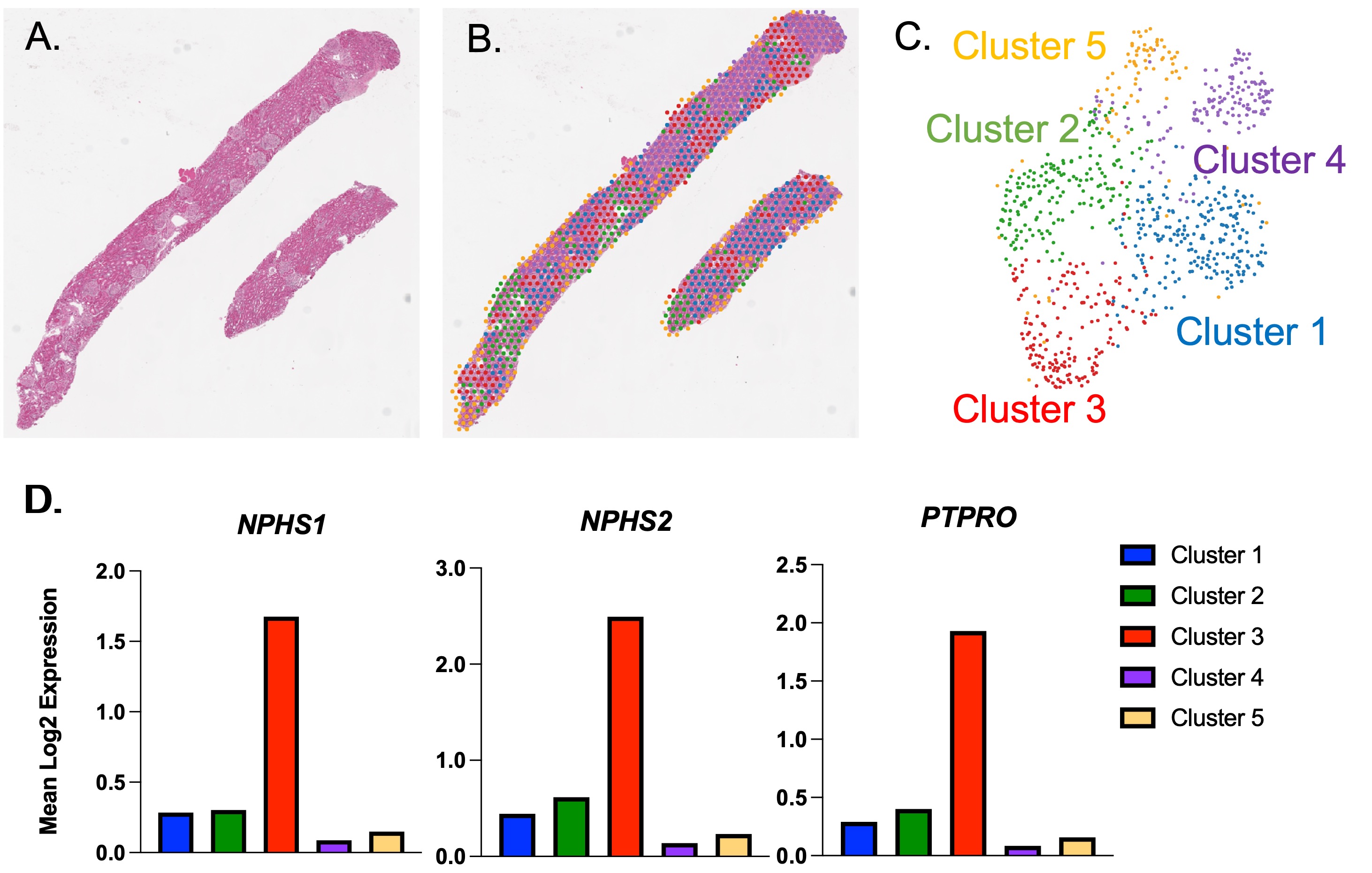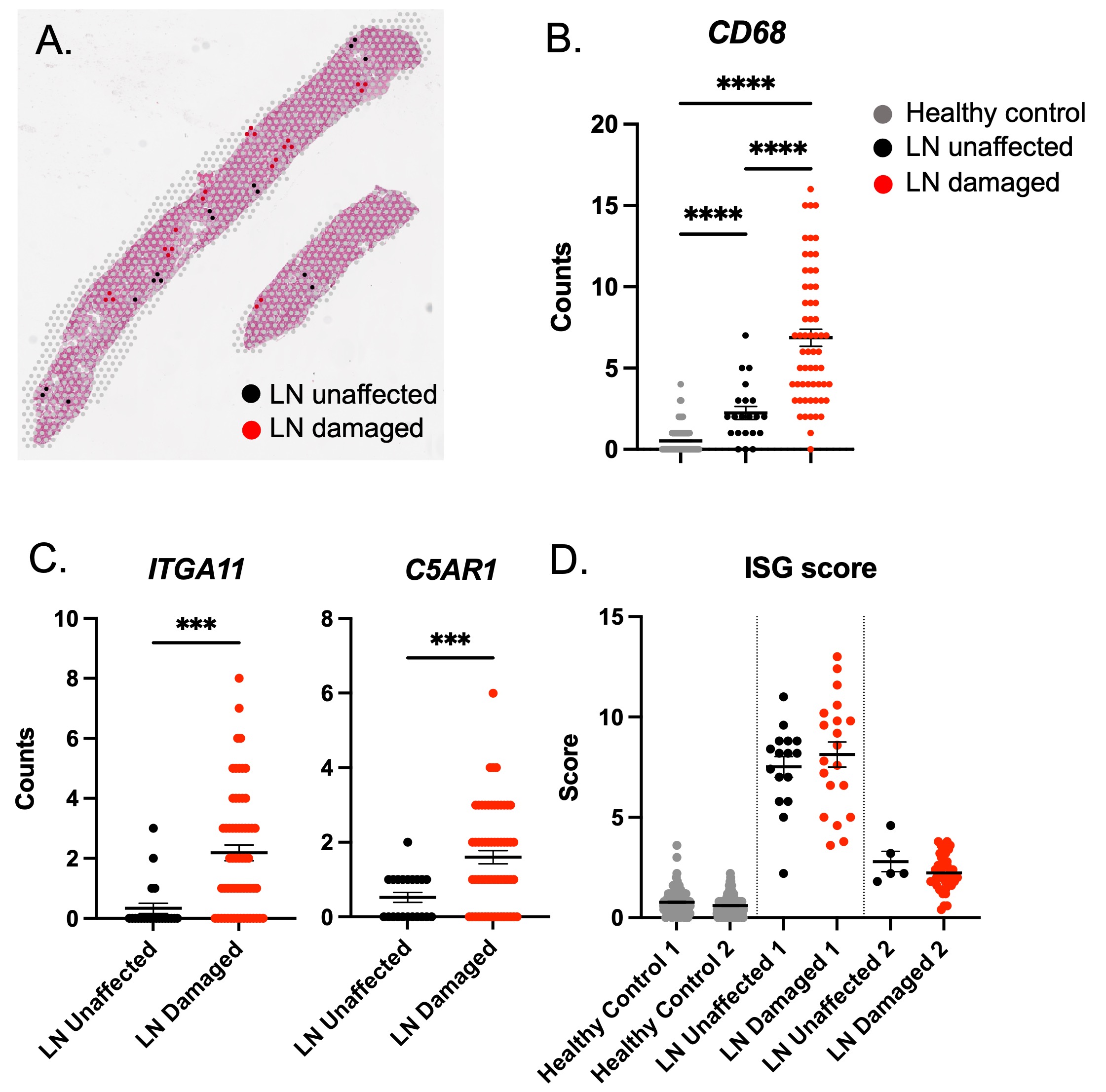Session Information
Session Type: Abstract Session
Session Time: 3:00PM-4:30PM
Background/Purpose: Lupus nephritis (LN) occurs in over 50% of patients with pediatric systemic lupus erythematosus (pSLE) and results in significant morbidity due to suboptimal kidney remission rates and the sequelae of prolonged intensive immunosuppressive therapy. While the proximal drivers of LN remain obscure, Type I interferon (IFN) has often been invoked in pathogenesis. LN is often patchy, with some glomeruli severely damaged while others remain histologically unaffected in the same kidney. Yet, the factors that drive these patterns of local injury are unclear. Using novel spatial transcriptomic technology, we interrogated microanatomic transcriptional differences between histologically damaged and unaffected glomeruli in pSLE LN to understand local drivers of glomerular damage.
Methods: Archived pre-treatment FFPE pediatric renal biopsies were stained with H&E. Using the Visium 10x platform, spatially barcoded gene expression libraries mapped to 55μM diameter spots were sequenced. A pediatric pathologist identified histologically damaged and unaffected glomeruli based on H&E staining. Loupe Browser (10X Genomics) was used to annotate damaged versus unaffected glomeruli and associated barcoded spots. Differential gene expression analysis of spots was performed in R. 2 cases of pSLE Class III LN, 2 cases of non-SLE glomerulonephritis (GN, C3 glomerulopathy and post-streptococcal GN), and 2 “healthy control” kidneys resected for non-immune pathology were assessed.
Results: High quality RNA was obtained from each specimen. Unsupervised clustering of spots identified glomeruli transcriptionally with excellent concordance to their microanatomic location (Figure 1). Differential gene expression analysis confirmed that pSLE glomeruli are transcriptionally distinct from non-SLE GN glomeruli and healthy control glomeruli. Moreover, among pSLE Class III LN glomeruli, damaged and unaffected glomeruli have unique transcriptional signatures. Predictably, damaged LN glomeruli have increased expression of the myeloid marker CD68 compared to unaffected LN glomeruli and healthy control glomeruli (Figure 2B). Damaged LN glomeruli also have increased expression of C5AR1 and ITGA11 compared to unaffected glomeruli, implying complement component 5a involvement and myofibroblast/fibrosis respectively (Figure 2C). Interestingly, while IFN stimulated gene (ISG) expression is elevated in pSLE compared to healthy control glomeruli, ISG expression is no different between damaged and unaffected LN glomeruli from the same kidney (Figure 2D).
Conclusion: Despite being canonically thought of as a disease of Type I IFN, IFN gene response does not associate with local glomerular damage in pSLE. Rather, non-IFN related transcriptional events associate with damage including C5aR and ITGA11. These results suggest novel useful biomarkers and potential therapeutic targets for LN (eg. avacopan to target C5aR). Resolution of the local transcriptional events associated with injury in LN compared to non-SLE GN reveals novel biology that will inform future mechanistic studies using animal models, and translational clinical studies by pointing to novel targets.
To cite this abstract in AMA style:
McCuaig S, Kreiger P, Behrens E. Spatial Transcriptomic Assessment of Histologically Damaged and Unaffected Glomeruli in Class III Pediatric Lupus Nephritis Reveals Distinct Transcriptional Programs [abstract]. Arthritis Rheumatol. 2024; 76 (suppl 9). https://acrabstracts.org/abstract/spatial-transcriptomic-assessment-of-histologically-damaged-and-unaffected-glomeruli-in-class-iii-pediatric-lupus-nephritis-reveals-distinct-transcriptional-programs/. Accessed .« Back to ACR Convergence 2024
ACR Meeting Abstracts - https://acrabstracts.org/abstract/spatial-transcriptomic-assessment-of-histologically-damaged-and-unaffected-glomeruli-in-class-iii-pediatric-lupus-nephritis-reveals-distinct-transcriptional-programs/


